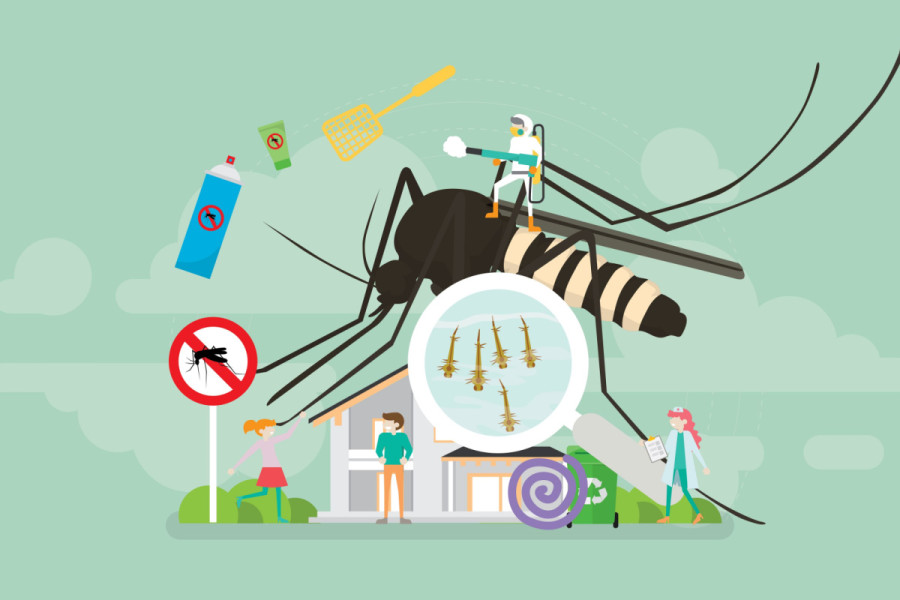Columns
Fighting with dengue menace
Dengue cases in Nepal abate, but the threat from the vector-borne disease remains.
Smriti Chapagain & Sumesh Shiwakoty
In recent days, cases of dengue are gradually de-escalating with the start of the winter season. However, until October, there were about 46,768 reported cases of dengue infection in Nepal. The most recent and explosive dengue outbreak was that of 2019, but this year’s dengue outbreak in Nepal broke the previous highest record of 17,992 cases of 2019, in mid-September. Experts assume that the climate change-induced late monsoon that many parts of Nepal observed this year might have triggered a breeding ground for dengue-causing mosquitoes. Now since the cases of dengue have started slowly waning, there is a higher probability that our government will forget to self-assess why its response at the peak of the dengue outbreak was sluggish and moving forward what Nepal should do to stay resilient against such vector-borne diseases.
Disease burden
Like Covid-19, the actual disease burden of dengue is hard to decipher, as a significant number of cases remain asymptomatic. Dengue is currently endemic in 129 countries, posing risk to around 3.9 billion people worldwide. The World Health Organization has reported that dengue cases amplified eight folds from 2002 until 2019, and 70 percent of the global burden of disease is in Asia.
Dengue is not new to Nepal, with frequent outbreaks since its first identification in 2004. This year as well, it has affected the entire nation with 54 deaths reported till October alone. Dengue-causing mosquitoes generally reside in lowland and urban areas. The plain areas of Terai thus provide a suitable climate for dengue-causing Aedes mosquitoes. However, interestingly, in recent years, the majority of dengue cases are concentrated in Kathmandu valley despite its higher altitude. A recent study points out that rising temperatures caused by climate change and urbanisation may further intensify viral replication and longevity in already-infested areas, risking massive vector-borne diseases outbreaks in upcoming years as well.
Prevention and treatment
As a starting point, effective mosquito control measures are vital in halting vector-borne diseases progression. In addition, community awareness and involvement are of utmost importance as well. Further, wearing full-sleeved clothes, using mosquito nets and repellants, covering water containers, and searching and destroying mosquito-breeding areas should be undertaken.
No specific treatment is available for dengue yet. The currently available dengue vaccine is of limited use. However, various research have shown that hydration, rest, and medicines that are used for fever and pain are beneficial for supportive care. On the other hand, the use of Aspirin and Ibuprofen is generally discouraged due to the risk of exacerbation of bleeding disorder.
Initiatives to contain dengue
At the height of dengue outbreak, Kathmandu Metropolitan city started a free consultation and free ambulance services for dengue patients. Further, the Epidemiology and Disease Control Division (EDCD) launched dengue control programme under which it allocated budgets for “search and destroy” campaigns, awareness for dengue prevention and distribution of dengue test kits to districts and provinces. In addition, regular monitoring of mosquitoes was started in a few districts, such as Lalitpur, Kathmandu and Dang. Data are being reported and published via weekly Early Warning and Reporting System (EWARS) reports. Also, the Ministry of Health stated that testing for Zika and Chikungunya virus was started in samples of dengue-infected patients.
However, moving forward, these approaches only are inadequate in making Nepal resilient to dengue in the future. It is interesting to note that cases of another mosquito-borne disease, Malaria, fell from 7.9 cases (2001) to zero per 1,00,000 people in 2020, and now it is in the pre-elimination phase. The National Malaria Strategic Plan (2014-2025) foresees eliminating malaria by 2025. Since mosquitoes transfer both malaria and dengue, it should be insightful to study the suitability of malaria elimination strategies to contain dengue.
Approaches used by other countries
The so-called enhanced 4S strategy has been adopted by countries like India and the Philippines which consists of “search and destroy”, “seek early consultation”, “self-protection measures”, and “say yes to fogging (insect control) in the event of an impending outbreak”. To adhere to this strategy, the 4 o’clock habit was also advised in the Philippines, where water containers and breeding sites were searched and destroyed at 4 o’clock in every household weekly.
Furthermore, in 2011, a mosquito eradication programme was implemented in Far North Queensland, Australia, which was also a dengue hotspot. Until 2019, this eradication programme successfully reduced dengue cases by 93 percent, and therefore, Far North Queensland was declared dengue-free for the first time in over a century. For this programme, scientists introduced Wolbachia bacteria to mosquitoes via a breeding program. The Wolbachia-infested mosquitoes later bred with other wild female mosquitoes causing the reduced ability to transmit the virus. Later, Singapore also adopted Australia’s mosquito eradication technique and launched “Project Wolbachia” by starting a mosquito production facility. This technology, many entomologists believe, has the potential to save millions of lives globally and could play a decisive role in eradicating other mosquito-borne diseases like the zika, chikungunya, and yellow fever caused by the same species.
A similar trial of genetically engineered mosquitoes in the US has also shown promising results. The experiment produced male mosquitoes carrying unique genes, which, when mated with wild females, caused their female offspring to die before maturing.
What Nepal should learn
Instead of waiting for other countries to find such innovative solutions for mosquito-borne diseases with a motive to import them to Nepal later, the Nepal government itself should adequately fund such research initiatives at home for finding organic remedies that suit our context the best. Nepal already possesses capable manpower for conducting such research. All it needs to do is create a proper environment so that its competent citizens—both from inside and outside Nepal—can come together to conduct research at home.




 8.12°C Kathmandu
8.12°C Kathmandu














%20(1).jpg&w=300&height=200)

